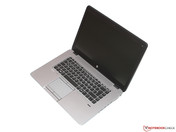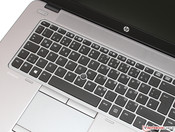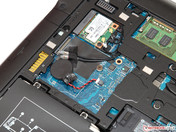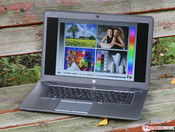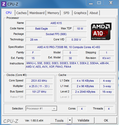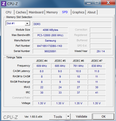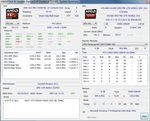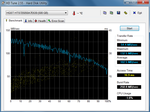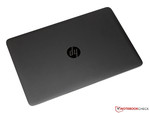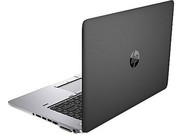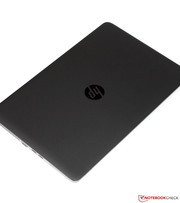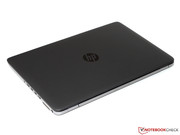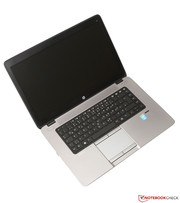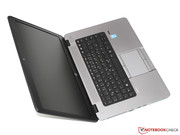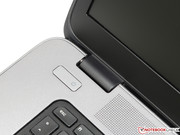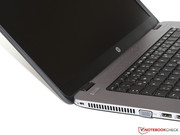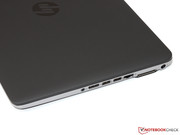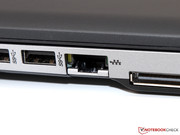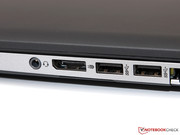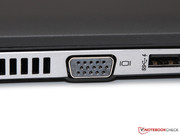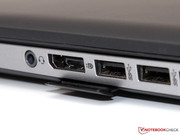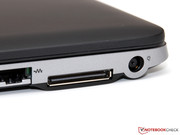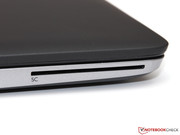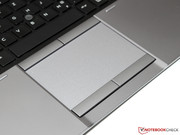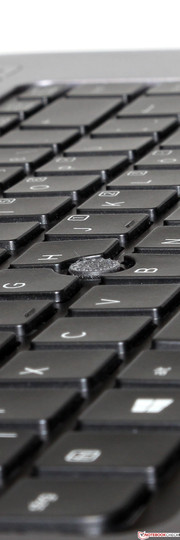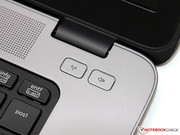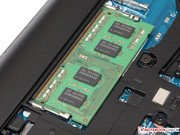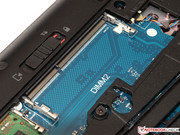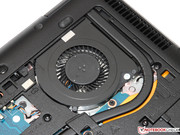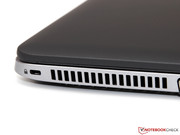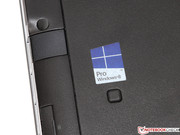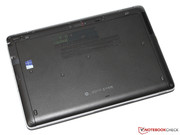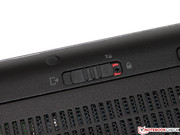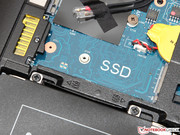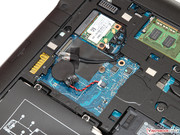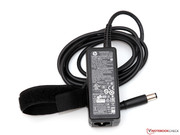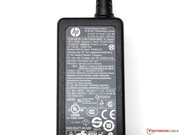HP EliteBook 755 G2 (J0X38AW) Notebook Review

For the original German review, see here.
It doesn't matter if it's a Lenovo ThinkPad, Dell Latitude or Fujitsu Lifebook - almost all high-priced business laptops currently feature the latest Intel processors. AMD also knows that and has therefore launched a dedicated CPU line specially designed for corporate customers, which is based on the recently introduced Kaveri architecture.
As the first (and until now) only manufacturer, HP has decided to add the new models in its own product portfolio. The EliteBook 755 G2 is seen as an affordable alternative to the previously tested 850 G1 model, and it shares the casing, input devices, and many other details with it. The 15-inch laptop is equipped with 4 GB of RAM, a 500 GB hard drive, and AMD's A10 Pro 7350B APU, and costs about 100 Euros (~$128) less than its in-house rival based on a Core i5 CPU. Not quite 900 Euros (~$1156) is demanded for the described configuration of the 755 G2. Buyers who need more power will have to opt for the top model with 8 GB of RAM and a 256 GB SSD for 1150 Euros (~$1478). It, unfortunately, could not be made available to us in time.
Since the swift Kaveri graphics unit clearly loses performance with only one memory module, we undertook a special measure - installing a second 4 GB bar. We want to find out what the new APU is capable of under ideal conditions with that. We used the results of the smaller EliteBook 745 G2 for comparison, which has to go through our test course in single-channel mode.
| EliteBook 755 G2 (F1Q28ET) | EliteBook 755 G2 (J0X38AW) | EliteBook 755 G2 (F1Q27ET) |
|---|---|---|
| A8 Pro-7150B | A10 Pro-7350B | A10 Pro-7350B |
| 4 GB RAM | 4 GB RAM | 8 GB RAM |
| 500 GB (HDD) | 500 GB (HDD) | 256 GB (SSD) |
| Radeon R5 | Radeon R6 | Radeon R6 |
| 1366x768 pixels | 1920x1080 pixels | 1920x1080 pixels |
| starts at 850 Euros (~$1092) | starts at 900 Euros (~$1156) | starts at 1150 Euros (~$1478) |
Differences from the EliteBook 850 G1
At first glance, the EliteBook 850 G1 and 755 G2 look absolutely identical - but there are slight differences in the details that we would now like to deal with. The keyboard backlight of the Intel model has been omitted in the 755 G2, although the keyboard itself has been adopted without modifications. HP's website, however, states that other configurations do have this feature. Beyond that, the list of security features is a bit shorter, and the internal M.2 slot has been axed so that installing an additional SSD is not possible. The user can only take out the existing hard drive and replace it with another 2.5-inch drive here.
Display
Potential buyers of the EliteBook 755 G2 can choose between two different screens. While the basic configuration has to be satisfied with a meager WXGA screen (1366x768 pixels), the two more expensive models are treated to a high-resolution Full HD screen. Alongside the 15.6-inch screen size, the pixel density climbs from 100 to 141 dpi, which results in a visibly sharper display of content. Furthermore, the considerably larger desktop facilitates using projecting Excel spreadsheets and other intricate software.
Surprisingly, our review sample was shipped with a screen from AUO in contrast to the 850 G1 that sports a model from the competitor Chi Mei. However, we can allay any fears that the affordable AMD version of the EliteBook is fobbed off with an inferior quality screen. Quite the opposite: With a maximum brightness of up to 312 cd/m², the in-house rival (292 cd/m² in the first, 264 cd/m² in the second test) is even surpassed marginally. The illumination of a good 85% does not give reason for complaint either.
| |||||||||||||||||||||||||
Brightness Distribution: 85 %
Center on Battery: 335 cd/m²
Contrast: 549:1 (Black: 0.61 cd/m²)
ΔE ColorChecker Calman: 10.51 | ∀{0.5-29.43 Ø4.79}
ΔE Greyscale Calman: 12.39 | ∀{0.09-98 Ø5}
53% AdobeRGB 1998 (Argyll 1.6.3 3D)
57.9% AdobeRGB 1998 (Argyll 3D)
82% sRGB (Argyll 3D)
56% Display P3 (Argyll 3D)
Gamma: 2.48
CCT: 16146 K
Although the screen is based on the relatively cheap TN technology, the first impression of the image is impressive. With just 0.61 cd/m², the black reproduction is sufficiently rich so that a contrast ratio of 549:1 is achieved. Thus, the 755 G2 outstrips, for example, Lenovo's ThinkPad S540 (346:1), but not a high-quality IPS screen with rates of 1000:1 or more. These screens are now even found in many low-budget consumer devices - and consequently we would expect more from a premium laptop for corporate customers.
The same is true for the color calibration ex-factory. Unfortunately, the manufacturer has failed vigorously here, which is expressed in a visible bluish cast and a very high DeltaE of 10.5 (colors) and 12.4 (grayscale). We would recommend using an adapted color profile (download possible in the chart above), which reduces the shifts to a minimum. Only the limited color space cannot be improved and thus prevents using the laptop as a professional photo or graphics workstation.
Finally, we would like to briefly deal with the viewing-angle stability. It is not one of the screen's strengths due to the underlying TN technology. The screen is particularly sensitive to vertical movements and reacts with loss of contrast and color deviations. The user has slightly more elbowroom from the sides. Nevertheless, the EliteBook remains to be an office device for a single user.
Performance
Alongside the identically specified FX-7500, the A10 Pro-7350B is currently AMD's fastest ULV APU. The quad-core chip clocks with 2.1 to 3.3 GHz and is based on the recently introduced Kaveri architecture that should offer a somewhat higher per-MHz performance as well as better energy efficiency than the Richland precursor. As a so-called "Pro" model, the 7350B was designed especially for the needs of corporate customers; AMD advertises the corresponding APUs with a particularly high stability and longer durability. The TDP of the chip built in 28 nanometers is 19 watts, and thus slightly higher than those of the competition (Haswell ULV: 15 watts including chipset).
The actual highlight of Kaveri is doubtlessly the integrated graphics unit dubbed Radeon R6. Having 384 Shader units, it promises a performance on the level of a dedicated mid-range accelerator. We will see whether this results in higher frame rates further below. The GPU's real active clock rate should be the decisive factor because the 553 MHz specified by the manufacturer is only to be understood as the maximum Turbo speed.
As mentioned in the intro, we extended the existing working memory of our EliteBook with a second 4 GB module in DDR3-1600 standard to a total of 8 GB. This is the only way of finding out what AMD's Kaveri APU is capable of without the extreme limitation by the memory interface. Such a modification of review samples will, however, remain to be an absolute exception in future and was primarily due to the fact that the actually desired configuration (F1Q27ET) was, unfortunately, not available at the time of testing. We did not perform any other modifications, for example, with the internal 500 GB hard drive, beyond that.
Processor
Four CPU cores, a clock rate of up to 3.3 GHz - the technical specs of the 19-watt chip look really impressive at first. However, the notorious "but" follows: First, the performance per clock is still far below that of the competition, and then the impressive Turbo headroom is utilized only very inadequately. The frequency fluctuates only between 2.5 and 2.8 GHz even in the single-thread benchmarks; just 1.9 to 2.1 GHz is achieved when both modules are loaded. That naturally has an impact on the performance. A Core i5-4200U surpasses that by 30 to 60% depending on the application, and the A10 Pro-7350B also has a hard time competing against a Core i3-4030U. We would have definitely expected more here, especially since AMD's even more frugal and cheaper A6-6310 does not calculate very much slower. No performance differences between battery and AC modes were noticed.
Storage Devices
Although the user does not get a swift SSD in the lower-priced configuration of the 755 G2, a small comfort is the fast 500 GB HDD with 7200 revolutions per minute. In contrast to most conventional hard drives, the considerably higher speed of the HGST Travelstar Z7K500 not only improves the access time to an acceptable 16.9 milliseconds, it also ensures remarkable transfer rates. A good 102 MB/s in the HD Tune benchmark is absolutely impressive for a conventional magnetic storage device. However, the EliteBook naturally cannot quite match the responsiveness of an accordingly more expensive SSD system.
System Performance
Complying with the wishes of corporate customers, HP still preloads Windows 7 Professional as the operating system. Additionally, the more up-to-date Windows 8.1 Pro is included as a free upgrade. The subjective application performance does not give much reason for complaint after the laptop finishes booting in about 40 seconds. The processor has enough performance reserves to easily cope with common office and multimedia tasks. The A20 Pro 7350B can also deal with more demanding software but remains far behind the contenders based on Core i5 CPUs. For example, the EliteBook 850 G1 clearly takes the lead in PCMark 7 with 2821 vs. 2052 points, although neither device sports an SSD or hybrid hard drive.
| PCMark 7 Score | 2052 points | |
| PCMark 8 Home Score Accelerated v2 | 2440 points | |
| PCMark 8 Creative Score Accelerated v2 | 2539 points | |
Help | ||
Graphics Card
Of the Kaveri's 512 GCN Shaders, only 384 units are active in the Radeon R6. Only the 35-watt FX-7600P top model offers the full extension of the chip with its Radeon R7. However, the memory interface is more important for the performance, which is the decisive bottleneck. The bandwidth is just 25.6 GB/s even with the ideal dual-channel configuration and DDR3-1600 that the GPU and processor have to share. But then, (almost) every integrated graphics solution struggles with the same problem.
The Radeon R6 conducts its strong Shader power quite well on the virtual lane in the synthetic 3DMark 11, which is comparatively easy on the bandwidth. A lead of approximately 50% on the HD Graphics 4400 (also with dual-channel interface) underlines AMD's superiority in the graphics field. Only the jerky playback of our 4K test video (H.264, 100 Mbps) was disappointing - Intel's contenders do a better job here.
| 3DMark 11 - 1280x720 Performance GPU (sort by value) | |
| HP EliteBook 755 G2 | |
| HP EliteBook 850 G1-H5G34ET | |
| HP EliteBook 850 G1-H5G44ET | |
| Toshiba Tecra Z50 A-12K | |
| HP Elitebook 745 G2 | |
| 3DMark 06 Standard Score | 5989 points | |
| 3DMark Vantage P Result | 4114 points | |
| 3DMark 11 Performance | 1306 points | |
| 3DMark Ice Storm Standard Score | 32732 points | |
| 3DMark Cloud Gate Standard Score | 3787 points | |
| 3DMark Fire Strike Score | 837 points | |
Help | ||
Gaming Performance
The difference between the Radeon R6 and HD 4400, both with the same memory configuration, diminishes slightly to approximately 20% on average in the real gaming benchmarks. Although smooth gaming fun will not emerge from absolutely unplayable frame rates, some higher detail settings can certainly be selected. Nevertheless, more than low to medium settings and 1024x768 pixels are only rarely possible in current games.
The graphics unit's performance will likely be boosted noticeably with a higher TDP specification. The core clock drops to approximately 400 MHz during simultaneous CPU and GPU load in order to comply with the 19 watts specified for the entire APU.
| HP EliteBook 755 G2 Radeon R6 (Kaveri), A10 Pro-7350B, Hitachi Travelstar Z7K500 HTS725050A7E630 | HP EliteBook 850 G1-H5G34ET HD Graphics 4400, 4200U, Hitachi Travelstar Z7K500 HTS725050A7E630 | HP Elitebook 745 G2 Radeon R6 (Kaveri), A10 Pro-7350B, Hitachi Travelstar Z7K500 HTS725050A7E630 | Toshiba Kirabook 2014 HD Graphics 4400, 4500U, Toshiba THNSNJ256GMCT | |
|---|---|---|---|---|
| Tomb Raider | -34% | -25% | -11% | |
| 1024x768 Low Preset (fps) | 51.5 | 37.2 -28% | 38.1 -26% | 48.6 -6% |
| 1366x768 Normal Preset AA:FX AF:4x (fps) | 26.3 | 17.9 -32% | 19.9 -24% | 25.1 -5% |
| 1366x768 High Preset AA:FX AF:8x (fps) | 18.3 | 10.4 -43% | 13.7 -25% | 14.3 -22% |
| BioShock Infinite | -36% | -34% | ||
| 1280x720 Very Low Preset (fps) | 46 | 31.2 -32% | 30.9 -33% | |
| 1366x768 Medium Preset (fps) | 26.8 | 17.3 -35% | 17.4 -35% | |
| 1366x768 High Preset (fps) | 23.2 | 13.9 -40% | 15 -35% | |
| Total Average (Program / Settings) | -34% /
-34% | -31% /
-30% | -23% /
-23% |
| low | med. | high | ultra | |
|---|---|---|---|---|
| Anno 2070 (2011) | 64.6 | 31 | 19.3 | 9.1 |
| Diablo III (2012) | 54.8 | 37.1 | 31.4 | 20.7 |
| Tomb Raider (2013) | 51.5 | 26.3 | 18.3 | 8.5 |
| BioShock Infinite (2013) | 46 | 26.8 | 23.2 | 7 |
| Metro: Last Light (2013) | 20.5 | 16.2 | 10.1 | 5.1 |
| Dota 2 (2013) | 43.8 | 27.6 | 15.1 | |
| Total War: Rome II (2013) | 35.5 | 26.8 | 22.7 | 6.3 |
| Thief (2014) | 12.5 | 9 | 6.9 | 3.6 |
Emissions
System Noise
It is primarily the quiet noise of the fast-spinning hard drive that dominates the background noise in idle. The user will rarely hear the fan; it is usually inactive or spins with such low speeds during basic office tasks that it is only vaguely audible a few centimeters away from the laptop. HP should only improve one point: When the fan turns on, it speeds up to almost 4000 rpm for a short moment - that can certainly be managed more discreetly.
The noise level increases to 34.3 to 37.1 dB(A) during full load, which is barely more than we measured in the EliteBook 850 G1 with a Haswell CPU (33.3 - 36.2 dB(A)). Only marginal differences exist compared with contenders like Lenovo's ThinkPad S540 (33.5 - 36.8 dB(A)) or Toshiba's Tecra Z50 (33.4 - 36.8 dB(A)). The frequency characteristic can be described as pleasantly low-pitched and consistent.
Noise level
| Idle |
| 30.9 / 30.9 / 31.6 dB(A) |
| HDD |
| 30.9 dB(A) |
| Load |
| 34.3 / 37.1 dB(A) |
 | ||
30 dB silent 40 dB(A) audible 50 dB(A) loud |
||
min: | ||
Temperature
The noticed, though not yet distracting, temperature increase of up to approximately 34 °C just in idle was a bit surprising. Since the fans in other contenders remain inactive when idling, this can only be the result of higher power consumption - but more about that in the following section. The average load rates of 38 °C were as we expected and are within an uncritical range. Consequently, the laptop can be used on the thighs without hesitation.
Despite a low core temperature of only 67 °C, the A10 APU throttled heavily in our stress test. A CPU clock of just 1.1 GHz is far remote from the actual base clock of 2.1 GHz. The graphics unit fluctuates between 280 and 410 MHz at the same time - as much as 553 MHz would be possible here. We assume that HP limits the chip's consumption before the maximum 19 watts in order to keep both the noise development and casing temperatures on a low level.
(+) The maximum temperature on the upper side is 39.9 °C / 104 F, compared to the average of 34.3 °C / 94 F, ranging from 21.2 to 62.5 °C for the class Office.
(±) The bottom heats up to a maximum of 43.7 °C / 111 F, compared to the average of 36.8 °C / 98 F
(±) In idle usage, the average temperature for the upper side is 33.5 °C / 92 F, compared to the device average of 29.5 °C / 85 F.
(+) The palmrests and touchpad are reaching skin temperature as a maximum (34.8 °C / 94.6 F) and are therefore not hot.
(-) The average temperature of the palmrest area of similar devices was 27.6 °C / 81.7 F (-7.2 °C / -12.9 F).
Energy Management
Power Consumption
Intel has raised the bar quite a few notches for idle and partial load consumption with Haswell (or better said, lowered it). Can Kaveri match that? In scenarios where the 850 G1 was satisfied with 4.9 to 9.3 watts, the EliteBook 755 G2 drains 7.2 to 12.4 watts from its included power supply. This will likely affect the battery runtime.
However, we would first like to look at the maximum consumption that was slightly lower than expected. 32.6 watts in 3DMark06 and 39.6 watts in the stress test (dropped to 33.7 watts after a short time) are relatively low for an APU of this TDP category. This backs our thesis that the rate AMD specifies is not fully exhausted, which again explains the throttling we observed.
| Off / Standby | |
| Idle | |
| Load |
|
Key:
min: | |
Battery Runtime
Just like the casing and input devices, HP also adopted the 50 Wh battery of the EliteBook 850 G1 in the 755 G2. However, our review sample only achieved consistently shorter runtimes with the simultaneously higher power consumption.
The 755 G2 was drained after almost 7 hours in Battery Eater's Reader's test using the energy-saving mode, minimum brightness, and disabled radio modules. That is roughly 1.5 hours sooner than the 850 G1. This test is only of little significance for practical use being a pure idle scenario and only illustrates the theoretical maximum runtime.
Our Wi-Fi and H.264 assessment using the energy-saving mode and a screen brightness of approximately 150 cd/m² is more interesting. The EliteBook has to be recharged after 3 to 4 hours at the latest, in contrast to the Intel model that lasted at least 1.5 to 2 hours longer.
We ascertained the smallest difference in Battery Eater's Classic test using the high-performance profile and maximum brightness. Here, the 755 G2's runtime of 1 hour and 34 minutes oppose the 850 G1's two hours. In a nutshell, this is at most a middling result for a high-priced business laptop. It will hardly last a whole workday with only one battery charge even with longer standby phases.
Verdict
Same quality, lower price: As to the casing's build, the screen or the input devices' properties, HP's EliteBook 755 G2 is an equal match for the at least 100 Euros (~$128) more expensive 850 G1. Well, almost because we do not want to keep the omitted keyboard backlight and axed M.2 slot a secret at this point.
Informed readers will have guessed that the A10 Pro-7350B cannot quite keep up with a swift Core i5 processor even before this test. The advantage of a Core i5-4200U ranges with about 30 to 60% according to our benchmarks and is thus also occasionally noticed in practical use. It would, however, be foolhardy to call the Kaveri APU sluggish - the chip has more than enough power for common office tasks and light multitasking. The tide turns when it comes to the graphics unit. AMD's relatively fast GPU will rarely pay off in a pure office device because the modern HSA concept hardly shows its assets in current applications. Furthermore, Intel's HD Graphics 4400 is only slightly behind the Radeon R6 that is apparently slowed down by memory and consumption limitations.
We deem the short battery runtime to be by far the biggest drawback of the 755 G2. The EliteBook shuts down in under four hours in everyday use, which makes having the power supply at hand essential. That is the main reason why it is difficult for us to give the laptop an unconditional purchase recommendation. Potential buyers would be well advised to wait for the announced EliteBook 750 G1, which is a somewhat less expensive version of the 850 G1 and thus a direct contender of the 755 G2.




